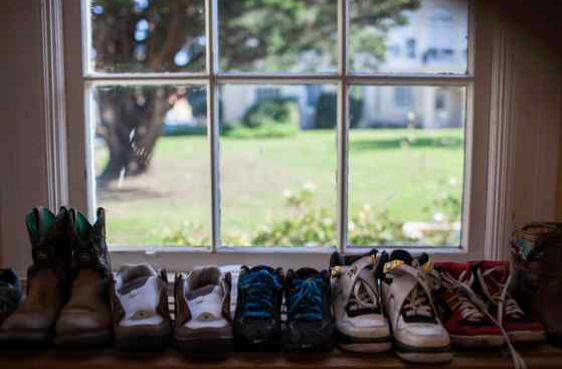
Children’s shoes line a windowsill at Edgewood, a San Francisco residential treatment facility for hard-to-place foster children and youth. Photo: Max Whittaker, Prime Collective
Roughly 7,600 years ago, researchers say, the Mediterranean Sea rose and spilled through the Bosphorus, flooding the Black Sea.
There are different theories about the speed of that flooding, with some experts pointing to geological evidence suggesting it was a catastrophic event that flooded 60,000 square miles of dry land in short order. Others say that the deluge took years, maybe even generations. Some have suggested that this event was the inspiration for the flood story of the Old Testament.
It may seem dramatic to evoke the flood when discussing child welfare, but something unstoppable and life altering has been inundating the field – and will continue to do so. And much like the “Black Sea Deluge” experts who suggest that the flooding of the hitherto fresh water lake took generations, I suggest that this change in child welfare has already started, is inevitable and is accelerating. Like those ancient peoples at the shore’s edge, the field will have to adapt.
The “sea change” I am pointing to is the field’s move away from the institutional care of children – whether in group homes or other congregate-care facilities – towards an ever-increasing reliance on relatives or non-relative foster parents.
The Imprint’s role is to tackle exactly this type of issue, so starting today, we launch our “Where Do We Go From Here?” reporting series, which will run into June, and take on key issues in successfully recruiting and retaining quality foster parents and relative caregivers.
Proposed federal legislation – like a recent law passed in California – would limit the system’s reliance on group homes and other congregate-care facilities.
This will force child-welfare systems, which have historically struggled with recruitment, to find homes for a larger and ostensibly more needy swath of children, begging the question: Where do we go from here?
I am very pleased that this series will delve into the myriad issues child welfare administrations face in placing children, and bright spots in both the public and private sectors that promise to help the system manage this change.
We will release stories examining how:
- A Colorado-based consortium of churches is finding permanent homes for foster youth, and taking their model nationwide.
- Los Angeles County is grappling with finding Native American foster homes for the largest population of urban Indians in the nation.
- One Pennsylvania county has successfully placed thousands of children with relatives, freeing up space in traditional non-relative foster homes and driving group home rates down.
- California and other states are using missed funding streams to train and recruit foster parents to care for children and youth with severe emotional and physical problems.
- Technological advances are helping match foster parents and children in Florida.
- A New Jersey non-profit is using data from strangers who “grant wishes” to foster youth to recruit foster parents.
- One single foster mother navigates teaching and raising a 2-year-old.
- A mosque in Detroit is recruiting foster parents.
We hope that this coverage will help the field adapt to the sea change on the horizon.
On May 11, we start it all with a Congressional Briefing produced alongside the Senate Caucus on Foster Youth and the Congressional Coalition on Adoption Institute. At that Washington, D.C. event we will share the first of our stories on faith-based recruitment and the Pittsburgh metropolitan area’s success finding relatives to take in kin.





